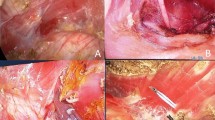Abstract
Purpose
The incision for breast augmentation can be chosen from the transaxillary, inframammary fold, periareolar, or transumbilical approaches. While the inframammary fold approach is commonly used worldwide, the transaxillary approach is more popular in Asia due to the more conservative location of the scar. In this study, we performed augmentation mammoplasty using anatomically shaped implants via the endoscopic transaxillary and inframammary fold incisions and compared the outcomes.
Methods
Three hundred sixty-four patients who underwent breast augmentation with shaped implants were enrolled. All were primary and bilateral cases. In total, 728 shaped implants were used. Patients’ demographics, incision type, and complications were documented. Complications such as capsular contracture, hematoma, infection, implant malposition, wound problem, and chronic seroma were observed during the average 27 months of follow-up period and analyzed.
Results
One hundred ninety-five patients underwent augmentation mammoplasty via the inframammary approach, whereas 169 patients underwent the endoscopic transaxillary approach. Implant type and size were matched between the two groups. Complication rates were 1.8% and 2.7% in the inframammary and transaxillary approach, respectively. There was no significant difference between the two approaches in terms of surgical complications (p = 0.593).
Conclusion
This study demonstrates that the endoscopic transaxillary approach is not inferior to the inframammary approach when shaped implants are used for augmentation mammoplasty. Therefore, the transaxillary approach may be an alternative method when using shaped implants for augmentation mammoplasty, especially for women who wish to avoid a visible scar on the inframammary fold.
Level of Evidence III
This journal requires that authors assign a level of evidence to each article. For a full description of these evidence-based medicine ratings, please refer to the Table of Contents or the online Instructions to Authors www.springer.com/00266.


Similar content being viewed by others
References
Heidekrueger PI, Sinno S, Hidalgo DA, Colombo M, Broer PN (2018) Current trends in breast augmentation: an international analysis. Aesthet Surg J 38:133–148
Stutman RL, Codner M, Mahoney A, Amei A (2012) Comparison of breast augmentation incisions and common complications. Aesthet Plast Surg 36:1096–1104
Zelken J, Cheng MH (2015) Asian breast augmentation: a systematic review. Plast Reconstr Surg Glob Open 3:e555
Somogyi RB, Brown MH (2015) Outcomes in primary breast augmentation: a single surgeon’s review of 1539 consecutive cases. Plast Reconstr Surg 135:87–97
Hidalgo DA, Spector JA (2014) Breast augmentation. Plast Reconstr Surg 133:567e–583e
Ince B, Dadaci M, Oltulu P, Altuntas Z, Bilgen F (2015) Effect of dermal thickness on scars in women with type III–IV Fitzpatrick skin. Aesthet Plast Surg 39:318–324
Adams WP Jr, Mallucci P (2012) Breast augmentation. Plast Reconstr Surg 130:597e–611e
Schwartz MR (2014) Algorithm and techniques for using Sientra’s silicone gel shaped implants in primary and revision breast augmentation. Plast Reconstr Surg 134:18S–27S
Sim HB, Sun SH (2015) Transaxillary endoscopic breast augmentation with shaped gel implants. Aesthet Surg J 35:952–961
Adams WP Jr, Culbertson EJ, Deva AK, Magnusson M, Layt C, Jewell ML, Mallucci P, Hedén P (2017) Macrotextured breast implants with defined steps to minimize bacterial contamination around the device: experience in 42,000 implants. Plast Reconstr Surg 140:427–431
Hidalgo DA, Sinno S (2016) Current trends and controversies in breast augmentation. Plast Reconstr Surg 137:1142–1150
Chong SJ, Deva AK (2015) Understanding the etiology and prevention of capsular contracture: translating science into practice. Clin Plast Surg 42:427–436
Maxwell GP, Van Natta BW, Bengtson BP, Murphy DK (2015) Ten-year results from the Natrelle 410 anatomical form-stable silicone breast implant core study. Aesthet Surg J 35:145–155
Li S, Chen L, Liu W, Mu D, Luan J (2018) Capsular contracture rate after breast augmentation with periareolar versus other two (inframammary and transaxillary) incisions: a meta-analysis. Aesthet Plast Surg 42:32–37
Tebbetts JB (2006) Axillary endoscopic breast augmentation: processes derived from a 28-year experience to optimize outcomes. Plast Reconstr Surg 118:53S–80S
Jacobson JM, Gatti ME, Schaffner AD, Hill LM, Spear SL (2012) Effect of incision choice on outcomes in primary breast augmentation. Aesthet Surg J 32:456–462
Acknowledgements
This paper has been presented at Aesthetica Supersymposium (March 2017) in New Orleans.
Author information
Authors and Affiliations
Corresponding author
Ethics declarations
Conflict of interest
Dr. Hanjo Kim is an Allergan Korea consultant for speaking events and marketing strategy.
Human and Animal Rights
All procedures performed in studies involving human participants were in accordance with the ethical standards of the institutional and/or national research committee and with the 1964 Helsinki Declaration and its later amendments or comparable ethical standards.
Informed Consent
Informed consent form was signed for all the patients who underwent surgery.
Additional information
Publisher's Note
Springer Nature remains neutral with regard to jurisdictional claims in published maps and institutional affiliations.
Electronic supplementary material
Below is the link to the electronic supplementary material.
Supplementary material 1 (WMV 257710 kb)
Rights and permissions
About this article
Cite this article
Lee, D.W., Kim, S.J. & Kim, H. Endoscopic Transaxillary Versus Inframammary Approaches for Breast Augmentation Using Shaped Implants: A Matched Case–Control Study. Aesth Plast Surg 43, 563–568 (2019). https://doi.org/10.1007/s00266-019-01324-6
Received:
Accepted:
Published:
Issue Date:
DOI: https://doi.org/10.1007/s00266-019-01324-6




